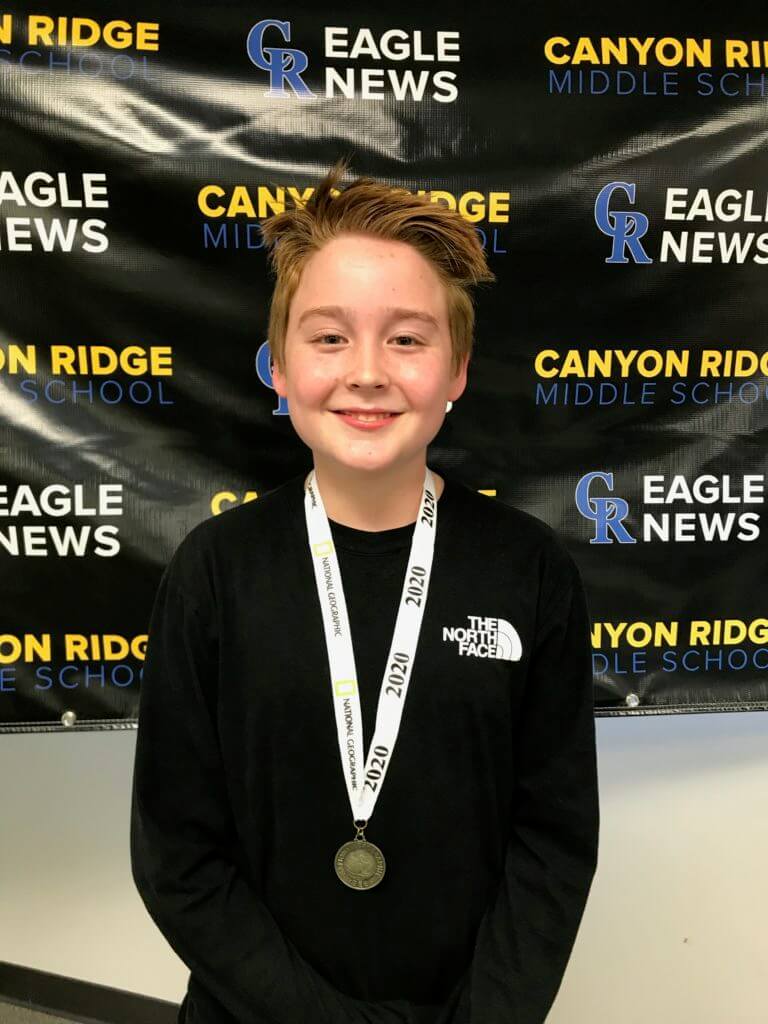
Xavier Leffler, an outgoing 8th grader at Canyon Ridge Middle School, qualified to compete at state for a chance to go to the National Geographic National Championship GeoBee, originally scheduled for May. PAGE BREAK
“It felt great winning the school competition and then qualifying for the state competition,” said Xavier, whose parents are Jake and Janae Leffler of Steiner Ranch. “When it was all cancelled, I was sad and so disappointed because I thought I had a good chance at winning this year.”
Xavier, 14, wanted to make his school the first school to win back-to-back national championships in the GeoBee after Nihar Janga won last year.
“He’s been obsessed with geography since he was little,” said his father Jake. “When he was four, the only book he wanted to check out from the library was a book showing every flag in the world. He memorized them all, categorized them, and then quizzed us.”
This year, an estimated 2.4 million students competed in the National Geographic GeoBee, with 8,661 students becoming school champions. School champions also took an online qualifying test, which they submitted to the National Geographic Society.
In Texas, over 2,000 school champions took the online qualifying test, and the 100 top-scoring students were invited to compete in the State GeoBee as state semifinalists.
Kiann Betancourt, a social studies teacher and the GeoBee Coordinator at Canyon Ridge could not be more proud of her former student.
“I am so proud of all the hard work Xavier put in to be able to qualify for the state round of the competition,” Betancourt said. “It’s no easy task to compete against, and beat, hundreds of students across the state.”
Then COVID-19 hit the United States and cancelled the remaining competitive events.
National Geographic tried to plan a socially-distanced proxied test in lieu of the state championship, but after the schools all closed, they couldn’t figure out a way to make it fair.
As a consolation, they invited all the state finalists to an online call in late April to recognize them, play a fun Kahoot competition with the questions that National Geographic had prepared for the actual championship, and also hear from one of their experienced geographers.
Kahoot is an online quiz format where players are given 30 seconds pick the right answer to a question, and they get points for answering correctly, how many they answer correctly in a row, and how quickly they pick the correct answer once the question is presented.
About halfway through the competition, Xavier was in 1st place out of the 2,600 students that were playing when the whole system went down and kicked everyone out, said Jake.
The competitors moved on to a speech from Geographer Alex Tait, and then the kids got a chance to “stump the geographer” with their submitted questions.
Tait has an impressive amount of geography knowledge, but one kid did stump him with the following question: “What two countries realized they had the same flag when they arrived at the 1936 Summer Olympics?”
While the geographer was pondering his options, Xavier said to his parents, “that’s easy… it was Haiti and Liechtenstein… two horizontal stripes, blue over red. In fact, after the games, Liechtenstein added a crown to the upper left corner of their flag to differentiate.” Tait, however, did not get the question correct.
CRMS’ Betancourt hopes other students will become interested in geography after Xavier’s success.
“I hope this experience has inspired Xavier, as well as other students, to be curious about the world in which we live,” she said.
Xavier, who will start at Vandegrift in August, will not be eligible to compete again next school year. But he hopes that another Canyon Ridge Eagle will get the chance that he didn’t.
For questions about competing in the 2021 GeoBee, please contact Kiann Betancourt at Kiann.Betancourt@leanderisd.org.
GeoBee quiz?
The National Geographic GeoBee starts in December each year, and the National Championship normally occurs in Washington, D.C. at the National Geographic headquarters.
The national champion receives a $25,000 college scholarship and an all-expenses-paid Lindblad expedition to the Galápagos Islands aboard the National Geographic Endeavour ll. The 2nd-place finisher receives a $10,000 college scholarship, 3rd place receives a $5,000 college scholarship and seven runners-up will each receive $1,000 in cash, which the top three also receive.
How would you fare as a National Geographic GeoBee contestant? At the school GeoBees this year, students had to answer questions like these:
Which state is located west of Lake Huron—Minnesota or Vermont?
Minnesota
Known for the tree nuts resembling deer eyes, which midwestern state is called the Buckeye State—California or Ohio?
Ohio
A savanna elephant’s daily amount of dung contains more than 3,000 seeds. Savanna elephants can be found in Namibia and Mozambique on what continent?
Africa
Volcanic activity under Yellowstone National Park creates great spouts of heated water that erupt out of the ground. These water eruptions are called what—geysers or cyclones?
geysers
Which country does not border the Atlantic Ocean—Moldova, Angola, or Ireland?
Moldova
The ancient Babylonians of Mesopotamia developed an early example of what basic counting machine that is still in use today—abacus or sundial?
abacus
Host of the 1984 Winter Olympics, Sarajevo is the most populous city in which European country that was once a part of Yugoslavia?
Bosnia and Herzegovina
Once the western terminus of the Northern Pacific Railroad, Tacoma is a major port and industrial city in which northwestern state?
Washington
Government designated preserves have helped protect giant tortoises in the Seychelles, a country made up of over one hundred islands located north of Madagascar in what ocean?
Indian Ocean
The Matterhorn is an iconic peak in the Alps on the border between Switzerland and what other country?
Italy
